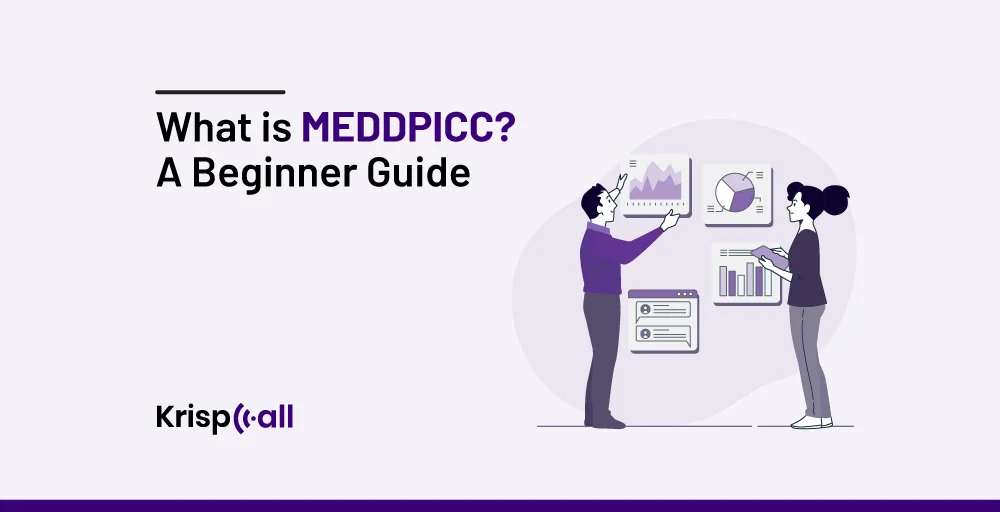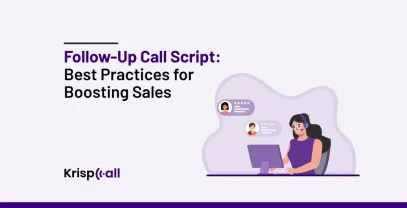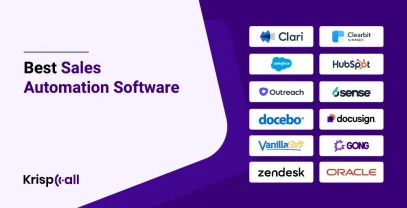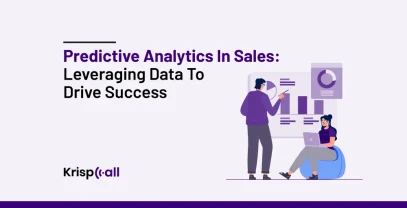Closing a deal in today’s competitive sales environment is like solving a puzzle in the middle of a busy road. Imagine this: you have invested a lot of time researching to find the right prospects, selling the product, and even bargaining for the best deal. Then, you encounter a major challenge at the last stage. 😣
Sounds frustrating, right? However, it is one of the many challenges that many sales professionals have to go through. 😞
But you don’t have to worry! With MEDDPICC, you can navigate the twists and turns of the MEDDPICC sales process, avoiding missed steps and lost opportunities. 😁
So, having said that, let’s explore MEDDPICC in more detail so that you can learn about it and be able to move through the sales maze effectively, qualify your prospects, and sell more than you have ever sold before. 🎉
🔐 KEY HIGHLIGHTS
- MEDDPICC is a sales qualification framework that helps salespeople qualify and close complex deals.
- Quantifiable metrics, economic buyers, decision criteria, decision process, paper process, identifying pain, champion, and competition are the main components of MEDDPICC.
- By using MEDDPICC, you can have benefits like improved lead qualification, faster sales cycles, increased win rates, enhanced sales productivity, and improved forecasting accuracy.
- MEDDPICC is an evolution of MEDDIC that includes additional steps to address the complexities of modern sales, such as understanding the paper process and competition.
- MEDDPICC is famous for customer needs alignment, sales cycle efficiency, complex sales adaptability, better prospect qualification, and competitive advantage.
What is MEDDPICC?
MEDDPICC is a sales qualification framework that helps salespeople qualify and close complex deals. It stands for Metrics, Economic Buyer, Decision Criteria, Decision Process, Paper Process, Implicate the Pain, Champions, and Competition.
Sales reps need to go through every step of MEDDPICC to qualify leads more efficiently and focus their efforts on the most promising opportunities. By identifying economic buyers early, reps can align their solutions to their needs and goals.
Components of MEDDPICC
A systematic approach to MEDDPICC allows sales teams to qualify leads more effectively, shorten sales cycles, and target the most promising opportunities. It helps sales teams identify high-quality prospects and deals in complex B2B sales environments by providing a structured approach to gathering key information and nurturing critical relationships.
Here are the key components of it:
- Quantifiable Metrics: These measure your solution’s economic benefits and returns on investment (ROI). As a result, it ensures that the prospect has a compelling business case.
- Economic Buyer: It refers to a position or role that is responsible for making decisions concerning the purchasing of goods.
- Decision Criteria: These are the factors that drive the prospect’s purchase decision. It helps to understand the criteria that help you align your offering with what’s important to the prospect.
- Decision Process: This component involves understanding the steps and people involved in the prospect’s decision-making process.
- Paper Process: This refers to the administrative procedures the prospect must follow to make a purchase, including procurement processes and contract approvals.
- Identify Pain: This involves understanding the key pain points or challenges that your solution can address for the prospect. It’s essential for creating a compelling value proposition.
- Champion: This is an influential person within the prospect’s organization who supports your solution and can help drive the deal forward internally.
- Competition: It helps to identify and understand your competitors in the deal. This means their strengths and weaknesses, to position your offering better.
Benefits of Using MEDDPICC in Your Sales Strategy
Using the MEDDPICC sales methodology can provide several key benefits for your sales strategy. Some of these are:
Improved Lead Qualification
A key goal of MEDDPICC is to encourage sales reps to gather critical information about prospects early in the sales process. This includes their key pain points, decision criteria, and economic buyers. In this way, sales reps can better qualify leads and spend less time on unqualified prospects, reducing wasted time.
Faster Sales Cycles
With MEDDPICC’s sales methodology, sales teams can identify potential roadblocks and information gaps before they occur. By guiding decision-makers to the correct information throughout the sales pipeline stages, they can close deals more quickly.
Increased Win Rates
Lead and deal qualification done using the MEDDPICC approach generates higher-quality opportunities in the pipeline. It allows reps to prioritize deals that have the highest chances of closing and position their solutions more effectively against competitors. As a result, win rates are improved.
Enhanced Sales Productivity
MEDDPICC helps sales teams avoid wasting time on guesswork by providing a standardized process to gather key information. Using the right context and insights; reps can engage prospects in revenue-generating activities. In this way, limited sales resources can be used more efficiently.
Improved Forecasting Accuracy
With MEDDPICC, sales managers have better visibility into the health of the pipeline through the collection of data points such as economic buyers, decision criteria, and metrics. Consequently, forecasting and resource planning can be more accurate.
How to use MEDDPICC: A Step Guide
The use of MEDDPICC sales methodology can help you increase your chances of closing deals. Every letter plays a vital role in the framework so that you can know the areas where your attention is required.
So, let’s see how you can use this framework to achieve your sales objectives.
1. Quantify The Economic Benefit To The Prospect With Metrics
Selling something to someone is impossible unless you know what the buyer is expecting to gain. That’s where the Metrics come into play. Metrics are quantifiable measures that demonstrate the economic impact your solutions can have on the prospect’s business. These metrics help to build a compelling case by showcasing the potential ROI.
For instance, “Implementing our software can cut your production cycle time by 15% and allow you to produce 10% more units each month.”
To begin with, you should ask the right questions.
Questions to ask:
- What are your current costs in [specific area] (e.g., labor, materials, marketing)?
- How much revenue do you currently generate from [specific product/service]?
- What are your targets for cost reduction or revenue growth this year?
2. Find The Decision-Maker, Also Known As The Economic Buyer
Most of the time in the sale process, identifying an economic buyer is crucial. The economic buyer is the one who has authority to approve the purchase and allocate the necessary budget for your solutions.
Similarly, the decision maker in the economic buyer mostly includes senior levels such as the CEO, CFO, or department head.
So, to identify the economic buyer, you can ask a direct question.
Questions to ask:
- Can you tell me who has the final say on purchasing decisions in your department?
- Who would need to be involved in the final approval process for this purchase?
- Who oversees the budget for this project?
- Which executive would be most concerned with the ROI of this solution?
3. Understand The Prospect’s Decision Criteria
Understanding exactly what your economic buyer needs and how your solution aligns with their needs is the first step in identifying your economic buyer. For instance, cost per license, integration capabilities with existing systems, and scalability to accommodate future growth.
Consider decision criteria as a prospect’s wish list.
Whether your solution qualifies the prospect for the next stage or disqualifies them will depend on how your solution stacks up against their wishlist.
Questions to ask:
- What are the most important factors you consider when choosing a solution?
- Can you share the key criteria that will influence your decision?
- How do you prioritize factors like cost, functionality, and vendor reputation?
- What specific features are you looking for in a solution?
4. Find Out The Prospect’s Decision Process
As a next step, you need to understand how the prospect decides to make the final purchase. For instance, an initial discovery call, followed by a product demo, then a formal proposal review.
So, the prospect’s decision process is important because it helps to align your sales effort, anticipate potential challenges, and ensure compliance. Furthermore, during the decision-making process, a combination of technical and financial factors will be taken into account.
Here are some questions you might find helpful.
Questions to ask:
- Who are the key stakeholders involved in the decision process?
- What criteria do you use to evaluate potential solutions?
- What are the key milestones or approval stages in your decision process?
- Are there any specific timelines or deadlines we should be aware of?
5. Understand The Paper Process
This is a point where MEDDPICC and MEDDIC start to differ from each other. This step focuses on understanding how long the prospect’s decision-making process will take, especially with the legal department, since they’ll be doing most of the paperwork.
Knowing the steps and timeline involved in the paper process helps you understand the true timeline to closing a deal and avoid surprise deals. That said, it’s less urgent to nail this down in your first meeting. For instance, legal review, and privacy review.
In order to ensure that deals close on time, you must do this.
Questions to ask:
- Who needs to review and sign off on this agreement?
- What documents are required at each stage of the approval process?
- Are there any specific compliance or regulatory requirements we need to be aware of?
- What are the typical timelines for each step of the process?
- Is there a procurement or legal team that needs to be involved?
6. Understand The Implications Of Pain
The best way to convince your prospect to buy your product is to explain how it will solve a pain point they are experiencing. Some examples are the cost of production, employee turnover, and production delays. Additionally, your prospect will be able to see the benefits of choosing your solution by presenting them with a cost-benefit analysis and what will happen if they do not.
Also, you can understand the implications of pain by identifying the specific challenges, evaluating the impact, quantifying the pain, and aligning with the solution
Questions to ask:
- What are the biggest challenges your team is facing right now?
- How is this issue affecting your overall business performance?
- Can you quantify the financial impact of this problem?
- What are the consequences of not addressing this issue promptly?
- How does this challenge impact your team’s productivity and morale?
7. Connect With A Champion To Vouch For Your Solution
There will always be someone there who will see your product if it’s a good fit for the company you’re trying to sell it to. The goal here is to get that person to pitch your solution to you. In most cases, the champion is also the person who will most benefit from what you have to offer since they are most affected by the pain in the previous step.
But wondering how to connect with a champion? 🤔
Primarily, you must identify potential champions, invest your time in building relationships, and gain commitment.
Questions to ask
- Who within your organization is most excited about solving [specific problem]?
- Can you recommend someone who would benefit most from the features we discussed?
- Who do you think would be interested in the potential cost savings our solution offers?
- Could you introduce me to someone who understands the strategic importance of [your solution]?
8. Communicate What Sets You Apart From The Competition
Remember, you’re not the only option for a prospect when talking to them. They are likely being targeted by your competitors at the same time, or they are still considering other vendors who offer similar or alternative solutions.
Having said that, your UVP (Unique Value Proposition) should be clear and articulate why your solution is superior to alternatives in the market. It could be based on product features, customer service, pricing, or any other factor that provides value to your prospect.
For example, similar software solutions can be used in in-house development.
Questions to ask:
- What features of our product/service do customers value the most?
- How does our customer support compare to competitors?
- What pricing advantages do we offer that our competitors don’t?
- In what ways does our solution solve specific pain points better than alternatives?
- What feedback have we received from customers that highlights our unique strengths?
MEDDPICC vs. MEDDIC: What are the differences?
The main difference between them MEDDIC and MEDDPICC in their additional components. MEDDPICC is a methodology that has the ability to provide detailed analysis and is better for long-term and more intricate sales processes, which makes it more suitable for complex and high-sales environments.
On the other hand, MEDDIC provides an approach that is better suited for short sales cycles. This methodology is based on simplicity and focuses on sales, which makes it ideal for straightforward sales scenarios.
These frameworks offer structured approaches to understanding and engaging with prospects, but they differ in key areas that make each suited for different sales cases. However, the choice between them should be based on the specific needs of the sales process. With this understanding, your sales teams can choose the right methodology to enhance their effectiveness and close more deals.
Why is MEDDPICC famous?
MEDDPICC’s popularity is not defined by one reason only. With its ability to build components on the MEDDIC framework: Paper Process and Competition, it has already won by making complex work easier to do for the sales team. For more, you can see below:
1. Customer Needs Alignment
The MEDDPICC process ensures sales solutions that are closely tailored to the unique challenges and goals of each customer. This helps your teams to enhance the chances of sales success, trust and build long-term relationships.
2. Sales Cycle Efficiency
With the help of MEDDPICC, your sales process can be broken down into detailed steps. This allows your teams to get a better analysis from initial engagement to final deal closure. So, having said this, it enables you to streamline the sales cycle and improves forecasting accuracy.
3. Complex Sales Adaptability
MEDDPICC is particularly effective in complex enterprise and B2B sales environments with multiple decision-makers and lengthy buying processes. However, this structured approach helps sales professionals solve these complexities.
4. Better Prospect Qualification
Since MEDDPICC tends to provide a structured framework to qualify leads, it focuses on critical elements thoroughly. Such elements include economic buyers, decision criteria, and competitive landscape. This helps sales teams identify and prioritize opportunities with a higher likelihood of conversion.
5. Competitive Advantage
Not to mention, the MEDDPICC methodology creates strategies that directly focus on competition. As a result, your sales teams can develop targeted strategies to differentiate their offerings and win deals.
Through this, you can analyze the SWOT (strengths, weaknesses, opportunities, and threats) of your competitors so that your sales team can highlight the unique advantages of their offerings. So lastly, this approach ensures that your sales pitches and strategies are fine-tuned to address the competitive landscape.
Conclusion
Thus, MEDDPICC is not just another word for sales, but it is your key to success and domination in the B2B sales universe. We are no longer in the business of selling but in the business of identifying, filtering, and solving problems for prospects. When you have MEDDPICC in your tool kit, you will be able to frame better questions, get to the right decision-makers, and write value propositions that will create interest with your clients.
Well, with this strong and positively impacting methodology at your fingertips, what used to be a shot in the dark will become a customer-focused, evidence-based approach. Are you ready to step up your sales, get more clients, and dominate the competition?





